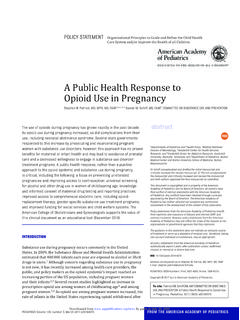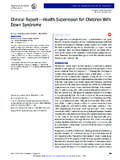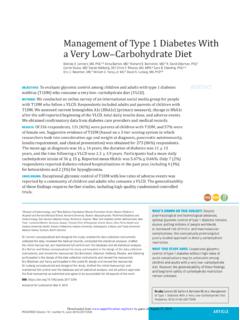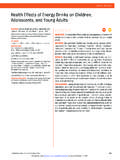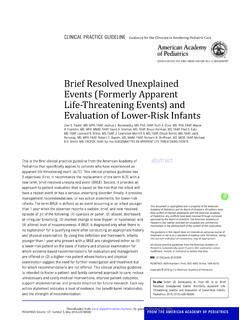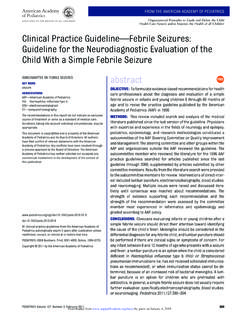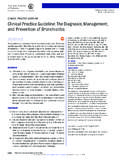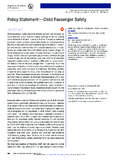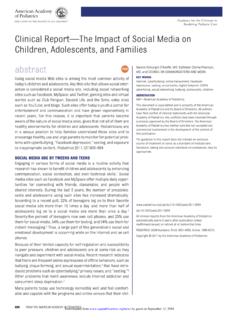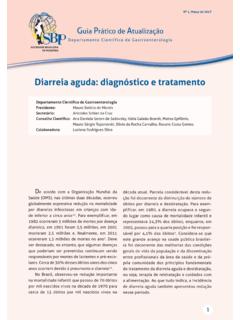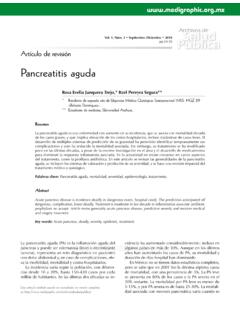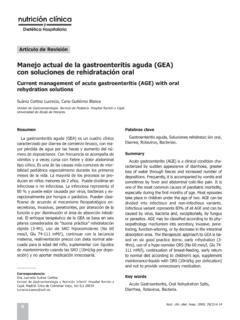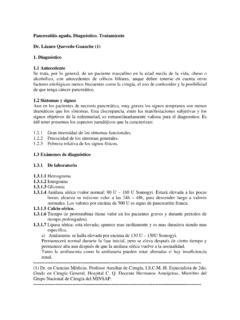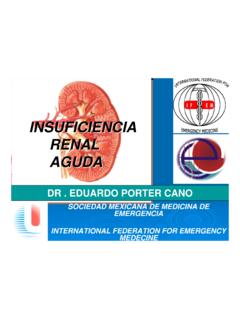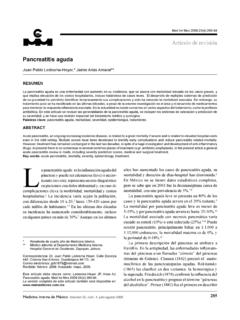Transcription of CLINICAL PRACTICE GUIDELINE Clinical Practice …
1 CLINICAL PRACTICE GUIDELINEC linical PRACTICE GUIDELINE for the Diagnosis andManagement of Acute Bacterial Sinusitis in ChildrenAged 1 to 18 YearsabstractOBJECTIVE:To update the American Academy of Pediatrics clinicalpractice GUIDELINE regarding the diagnosis and management of acutebacterial sinusitis in children and :Analysis of the medical literature published since the lastversion of the GUIDELINE (2001).RESULTS:The diagnosis of acute bacterial sinusitis is made when a childwith an acute upper respiratory tract infection (URI) presents with (1)persistent illness (nasal discharge [of any quality] or daytime cough orboth lasting more than 10 days without improvement), (2) a worseningcourse (worsening or new onset of nasal discharge, daytime cough, orfever after initial improvement), or (3) severe onset (concurrent fever[temperature 39 F] and purulent nasal discharge for at least3 consecutive days).
2 Clinicians should not obtain imaging studies of anykind to distinguish acute bacterial sinusitis from viral URI, because theydo not contribute to the diagnosis; however, a contrast-enhancedcomputed tomography scan of the paranasal sinuses should beobtained whenever a child is suspected of having orbital or centralnervous system complications. The clinician should prescribe antibiotictherapy for acute bacterial sinusitis in children with severe onset orworsening course. The clinician should either prescribe antibiotictherapy or offer additional observation for 3 days to children withpersistent illness. Amoxicillin with or without clavulanate is thefirst-line treatment of acute bacterial sinusitis. Clinicians should reassessinitial management if there is either a caregiver report of worsening(progression of initial signs/symptoms or appearance of new signs/symptoms) or failure to improve within 72 hours of initial the diagnosis of acute bacterial sinusitis is confirmed in a child withworsening symptoms or failure to improve, then clinicians may changethe antibiotic therapy for the child initially managed with antibiotic orinitiate antibiotic treatment of the child initially managed :Changes in this revision include the addition of a clin-ical presentation designated as worsening course, an option to treatimmediately or observe children with persistent symptoms for 3 daysbefore treating, and a review of evidence indicating that imaging isnot necessary in children with uncomplicated acute bacterial ;132:e262 e280 Ellen R.
3 Wald, MD, FAAP, Kimberly E. Applegate, MD, MS,FAAP, Clay Bordley, MD, FAAP, David H. Darrow, MD, DDS,FAAP, Mary P. Glode, MD, FAAP, S. Michael Marcy, MD, FAAP,Carrie E. Nelson, MD, MS, Richard M. Rosenfeld, MD, FAAP,Nader Shaikh, MD, MPH, FAAP, Michael J. Smith, MD, MSCE,FAAP, Paul V. Williams, MD, FAAP, and Stuart T. Weinberg,MD, FAAPKEY WORDS acute bacterial sinusitis, sinusitis, antibiotics, imaging, sinusaspirationABBREVIATIONSAAP American Academy of PediatricsAOM acute otitis mediaCT computed tomographyPCV-13 13-valent pneumococcal conjugate vaccineRABS recurrent acute bacterial sinusitisRCT randomized controlled trialURI upper respiratory tract infectionThis document is copyrighted and is property of the AmericanAcademy of Pediatrics and its Board of Directors. All authorshavefiled conflict of interest statements with the AmericanAcademy of Pediatrics. Any conflicts have been resolved througha process approved by the Board of Directors.
4 The AmericanAcademy of Pediatrics has neither solicited nor accepted anycommercial involvement in the development of the content ofthis recommendations in this report do not indicate an exclusivecourse of treatment or serve as a standard of medical , taking into account individual circumstances, may (ISSN Numbers: Print, 0031-4005; Online, 1098-4275).Copyright 2013 by the American Academy of Pediatricse262 FROM THE AMERICAN ACADEMY OF PEDIATRICSO rganizational Principles to Guide and Define the ChildHealth Care System and/or Improve the Health of all Children by guest on August 9, from INTRODUCTIONA cute bacterial sinusitis is a commoncomplication of viral upper respiratoryinfection (URI) or allergic stringent criteria to define acutesinusitis, it has been observed that be-tween 6% and 7% of children seekingcare for respiratory symptoms has anillness consistent with this 4 This CLINICAL PRACTICE GUIDELINE is a re-vision of the CLINICAL PRACTICE guidelinepublished by the American Academy ofPediatrics (AAP)
5 In has beendeveloped by a subcommittee of theSteering Committee on Quality Improve-ment and Management that includedphysicians with expertise in thefields ofprimary care pediatrics, academic gen-eral pediatrics, family PRACTICE , allergy,epidemiology and informatics, pediatricinfectious diseases, pediatric otolaryn-gology, radiology, and pediatric emer-gency medicine. None of the participantshadfinancial conflicts of interest, andonly money from the AAP was used tofund the development of the GUIDELINE will be reviewed in 5 yearsunless new evidence emerges thatwarrants revision GUIDELINE is intended for use ina variety of CLINICAL settings (eg, office,emergency department, hospital) byclinicians who treat pediatric data on which the recom-mendations are based are included ina companion technical report, pub-lished in the electronic for Policy Implementationhas developed a series of definitionsusing accepted health informationtechnology standards to assist in theimplementation of this GUIDELINE incomputer systems and quality mea-surement efforts.
6 This document isavailable at: revision focuses on the diagnosisand management of acute sinusitis inchildren between 1 and 18 years of does not apply to children with sub-acute or chronic sinusitis. Similar to theprevious GUIDELINE , this document doesnot consider neonates and childrenyounger than 1 year or children withanatomic abnormalities of the sinuses,immunodeficiencies, cysticfibrosis, orprimary ciliary dyskinesia. The mostsignificant areas of change from the2001 GUIDELINE are in the addition ofa CLINICAL presentation designated as worsening course, inclusion of newdata on the effectiveness of antibioticsin children with acute sinusitis,4anda review of evidence indicating thatimaging is not necessary to identifythose children who will benefitfromantimicrobial Subcommittee on Management ofSinusitis met in June 2009 to identifyresearch questions relevant to guide-line revision.
7 The primary goal was toupdate the 2001 report by identifyingand reviewing additional studies ofpediatric acute sinusitis that havebeen performed over the past of PubMed were performedby using the same search term as inthe 2001 report. All searches werelimited to English-language and humanstudies. Three separate searches wereperformed to maximize retrieval of themost recent and highest-quality evi-dence for pediatric sinusitis. Thefirstlimited results to all randomizedcontrolled trials (RCTs) from 1966 to2009, the second to all meta-analysesfrom 1966 to 2009, and the third toall pediatric studies (limited to ages<18 years) published since the lasttechnical report (1999 2009). Addi-tionally, the Web of Science was que-ried to identify studies that cited theoriginal AAP guidelines . This literaturesearch was replicated in July 2010 FIGURE 1 Levels of recommendations.
8 Rec, Volume 132, Number 1, July 2013e263 FROM THE AMERICAN ACADEMY OF PEDIATRICS by guest on August 9, from and November 2012 to capture re-cently published studies. The com-plete results of the literature revieware published separately in the tech-nical summary, 17 ran-domized studies of sinusitis inchildren were identified and 3 trials met inclusion of significant heterogeneityamong these studies, formal meta-analyses were not used to guide development of thekey action statements included in thisdocument. These action statementswere generated by using BRIDGE-Wiz(Building Recommendations in a Devel-opers GUIDELINE Editor, Yale School ofMedicine, New Haven, CT), an interactivesoftware tool that leads GUIDELINE de-velopment through a series of ques-tions that are intended to create a moreactionable set of key action also incorporates the qualityof available evidence into thefinal de-termination of the strength of AAP policy statement ClassifyingRecommendations for CLINICAL PracticeGuidelines was followed in designatinglevels of recommendations (Fig 1).
9 8 Definitions of evidence-based state-ments are provided in Table 1. Thisguideline was reviewed by multiplegroups in the AAP and 2 externalorganizations. Comments were com-piled and reviewed by the subcom-mittee, and relevant changes wereincorporated into the ACTION STATEMENTSKey Action Statement 1 Clinicians should make a pre-sumptive diagnosis of acute bacterialsinusitiswhenachildwithanacuteU RI presents with the following: Persistent illness, ie, nasal dis-charge (of any quality) or daytimecough or both lasting more than10 days without improvement;OR Worsening course, ie, worsen-ing or new onset of nasal dis-charge, daytime cough, orfever after initial improvement;OR Severe onset, ie, concurrent fe-ver (temperature 39 F)and purulent nasal discharge forat least 3 consecutive days (Evi-dence Quality: B; Recommenda-tion).KAS Profile 1 Aggregate evidence quality: BBenefitDiagnosis allows decisions regarding management to be made.
10 Childrenlikely to benefit from antimicrobial therapy will be diagnosis may lead to unnecessary treatment. A misseddiagnosis may lead to persistent infection or complicationsCostInappropriate diagnosis may lead tounnecessary cost of antibiotics. Amissed diagnosis leads to cost of persistent illness (loss of time fromschool and work) or cost of caring for assessmentPreponderance of of patient aged<1 year or older than 18 years and with 1 GUIDELINE Definitions for Evidence-Based StatementsStatementDefinitionImplication Strong recommendationA strong recommendation in favor of a particular action is madewhen the anticipated benefits of the recommendedintervention clearly exceed the harms (as a strongrecommendation against an action is made when theanticipated harms clearly exceed the benefits) and the qualityof the supporting evidence is excellent. In some clearlyidentified circumstances, strong recommendations may bemade when high-quality evidence is impossible to obtain andthe anticipated benefits strongly outweigh the should follow a strong recommendation unlessa clear and compelling rationale for an alternative approachis recommendation in favor of a particular action is made whenthe anticipated benefits exceed the harms but the quality ofevidence is not as strong.
